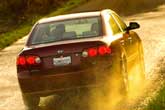Recent Articles
Popular Makes
Body Types
2006.5 Kia Optima First Drive
Optimizing value in the midsize sedan class
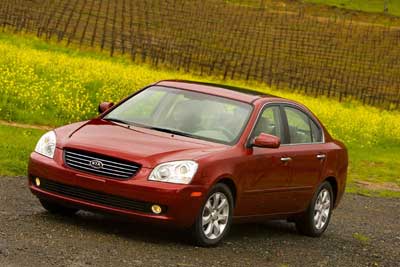
NAPA VALLEY, Calif. – Ask Kia executives pointed questions about the redesigned 2006.5 Optima midsize sedan, questions about the underwhelming V6 engine option, questions about why antilock brakes and traction control are options rather than standard equipment, questions about missing features like a navigation system, and they all spin the response to a single concept: value. That’s the driving theme behind the all-new 2006.5 Optima sedan, though advertising for the new car is going to pitch interior room, cabin quiet, and performance. After spending several days driving the new 2006.5 Kia Optima along beautiful country roads in California’s Napa Valley region, on the crowded city streets of San Francisco, and on a six-hour run down Interstate 5 to Los Angeles, we think Kia’s marketing department might want to focus more on the value equation and less on the Optima’s roominess, quietness, and performance. The Optima is certainly accommodating; given the right tires, road surfaces, and cruising speed the Optima is quiet; the standard four-cylinder engine is class competitive if not as thrifty as it should be; and the optional 17-inch Michelin tires provide entertaining handling capability. However, the car isn’t a standout in the midsize class. But the value story – now that holds some water. According to the Comerica Auto Affordability Index, the average price paid for a new car in 2005 was near $28,000. A 2006.5 Kia Optima EX V6 with all the bells and whistles runs $24,200, including the $600 destination charge. And that’s the sticker price, which is a blue sky proposition in the midsize market. With most of the Optima’s competitors going for invoice, or less, due to intense competition that forces even the class front-runners, the Honda Accord and Toyota Camry, to discount, nobody’s gonna buy this Kia for what’s shown on the window label. At the very least, that number represents the amount you’re rolling out the door for: tax, title, license, and killer warranty plan included. That puts a handsome car in the driveway, one with room for the spouse and kids, and one with both upscale touches and creature comforts. The 2006.5 Kia Optima is an entirely agreeable automobile, one designed to age gracefully while offering long-term protection from catastrophic component failure. But it’s not the most comfortable car in its class, it’s not the quietest car in its class, and it’s not the best performing car in its class. And that makes marketing the Optima as a spacious, quiet, performance sedan a difficult proposition.
Model Mix
Model Mix The 2006.5 Kia Optima is available in LX or EX trim with either a four-cylinder or a V6 engine, and few options are available. Prices range from just under $17,000 to about $24,000. Kia dealers will love that the redesigned 2006.5 Optima is priced at $16,995, including the $600 destination charge. After discounts, that’s going to make for a compelling Sunday newspaper advertisement. That price provides standard Optima LX trimmings including air conditioning, power windows, power door locks, power heated outside mirrors, a tilt steering wheel, a six-way manually-adjustable driver’s seat, a CD player with six speakers, a 60/40 split folding rear seat, an illuminated glove box, a trunk light, a battery saver, and other features. That also includes a 2.4-liter four-cylinder engine and a five-speed manual transmission. Add the optional five-speed automatic transmission with Sportmatic manual gear selection and the Optima LX also includes cruise control, keyless entry, a tilt and telescopic steering column, floor mats, and audio controls on the steering wheel for $18,250. Add to that the optional 2.7-liter V6 engine, and Kia tosses in alloy wheels and snazzy twin exhaust outlets for $19,945. Buyers seeking a full feature load will want to consider the 2006.5 Kia Optima EX at $19,995, including an automatic transmission. The EX models have alloy wheels, fog lights, solar glass, chrome door handles, metal door scuff plates, a trip computer, foot well lights, door courtesy lights, and a leather-wrapped steering wheel. But the main reasons to choose the EX over the LX are for its eight-way power adjustable driver’s seat, automatic climate control, auto-dimming rearview mirror with Homelink transmitter, and 360-watt Infinity audio with six-disc CD changer and cassette player. If you want a bigger and hungrier engine, the EX V6 adds horsepower, torque and dual exhaust outlets for $21,000. Every 2006.5 Kia Optima comes standard with an excellent warranty. Powertrain coverage is 10 years or 100,000 miles, whichever comes first. Bumper-to-bumper protection is five years or 60,000 miles, and you get free roadside assistance for the same time period. Kia protects Optima owners in other ways, too. Standard equipment includes dual-stage front airbags, front passenger detection sensors, front side-impact airbags, side-curtain airbags, active front headrests, a tire pressure monitoring system, and front seatbelts with pretensioners and force limiters. Antilock brakes with brake assist, traction control, and stability control are a packaged option for $600, but only on LX V6, EX, and EX V6. If you get the LX four-cylinder, you can’t have these important safety technologies. You can, however, look slicker than that snowy road you’re spinning around on with the LX Appearance Package, which runs $1,000 on the four-cylinder version and $800 if you’ve chosen the V6. This package requires the purchase of the optional automatic transmission and adds great-looking 17-inch alloy wheels wearing Michelin performance tires, a blacked-out grille and headlights, fog lights, a Supervision gauge cluster, a trip computer, automatic headlights, a leather-wrapped steering wheel and shift knob, aluminum interior trim, and silver accent interior door handles. A similar package is offered on the EX models, but includes black leather upholstery and black interior trim for $1,500. If you want leather seats on your Optima EX but want to keep the chrome-trimmed grille and 16-inch wheels that come standard on this model, select the Leather Package for $1,300. It adds leather seats, a power four-way front passenger’s seat, heated front seats, power adjustable pedals, and a rear window manual sunshade. The Optima EX, regardless of whether you’ve selected the Appearance Package or the Leather Package, can be equipped with an $800 power sunroof that features one-touch operation for opening but not closing. The EX models can also be painted a special Pearl White color for $100, a $200 rear spoiler can be added to any Optima, and the only option for the base LX with a four-cylinder engine and the manual transmission is floor mats for $85.
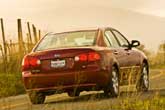
Nuts and Bolts
Nuts and Bolts Pop for the optional V6, and the 2006.5 Kia Optima will make a whopping 24 more horsepower and 19 lb.-ft. of torque while getting worse fuel economy. Why would you even bother? Kia plans to stockpile the new 2006.5 Optima in a ratio of 80:20, favoring the four-cylinder models over the V6 versions. The company’s spokespeople explain that the Optima is about value, and it’s the four-cylinder powertrain that offers the most bang-for-the-buck, especially with gas prices where they are and newfound consumer concerns about fuel economy. This strategy should pay off for Kia, thanks in no small part to the refined, class-competitive aluminum 2.4-liter four-banger with continuous variable valve timing (CVVT). This brand new engine design provides 15 percent more power than the motor it replaces, generating 161 horses at 5,800 rpm and 163 lb.-ft. of torque at 4,250 rpm. Kia says these power ratings are stronger than several competitors, but just barely so. It runs on regular unleaded, and the EPA says it will get 24 mpg in the city and 34 mpg on the highway, whether you’re rowing your own gears with the manual or letting the optional Sportmatic automatic transmission shift for you. We got a disappointing 23.4 miles per gallon, and that included a six-hour drive at speeds between 80 and 90 mph from San Francisco to Los Angeles. Kia recognizes that midsize sedan buyers want a V6 engine option, but the only thing in the parts bin that will fit is a carryover aluminum 2.7-liter V6 engine from last year’s Optima. Though upgraded with CVVT technology for a 10 percent increase in horsepower, and rated by the EPA to get better fuel economy than significantly more powerful V6 engines in some competitors, the Optima’s V6 is a dog. It makes a measly 185 horsepower at 6,000 rpm and 182 lb.-ft. of torque at 4,000 rpm, slurping regular unleaded at a rate of 22 mpg in the city and 30 mpg on the highway. And those are EPA figures. If the Optima V6 is as thirsty as the four-cylinder engine in the real world, expect a combined rating of 20 mpg or less. The 2006.5 Kia Optima rides on a MacPherson strut front and multi-link rear suspension with stabilizer bars at each end. An engine-speed sensitive power rack-and-pinion steering system guides standard P205/60 tires wrapped around 16-inch wheels or optional P215/50 rubber mounted on 17-inch alloys. Base LX models get steel wheels decorated with surprisingly attractive wheel covers, while LX V6 and EX versions have 16-inch alloy wheels as standard equipment. Cars equipped with the optional Appearance Package get the bigger 17-inch wheels. These wheel-and-tire combinations front a standard four-wheel-disc braking system, vented in front and solid in the rear.

Design
Design The 2006.5 Kia Optima is a handsome sedan, roomy enough for a quartet of adults and equipped with a logical control layout. But there is still work to be done on improving the interior materials. If nothing else, if history proves the second-generation 2006.5 Kia Optima to be a mid-pack competitor from the beginning, it’s a handsome machine. Even in base format, the LX four-banger with its plastic bolt-on wheelcovers, this car looks good. In fact, it looks like a luxury car, and if not for the oversized “Kia” badges front and rear your neighbors just might buy it as an entry-luxe European sport sedan. From the circular lighting elements to the dual exhaust outlets on V6 models, the Kia Optima is attractively and inoffensively designed. It’s also thoughtfully designed. Pop the hood and check out the single gas strut that supports it. There’s no cheapo prop rod to contend with here. Pop the trunk and check out those gas struts, too, along with how the lid angles past 90 degrees for maximum loading space. The Kia Optima can swallow 14.8 cubic feet of cargo in its usefully shaped, nicely lined trunk, and there’s a handy close assist grip to slam the lid shut without getting your fingertips dirty. Wider, and with a longer wheelbase, Kia says the new Optima has more interior passenger room than 2006 versions of the Honda Accord, Nissan Altima, and Toyota Camry. Too bad it doesn’t feel like it once you get inside. It is clear, however, that Kia is paying more attention to detail when it comes to crafting its interiors. The Optima features matching textures and grains, subtle accenting, and a pleasing blue-and-white nighttime illumination scheme. But there’s still work to be done in terms of materials. The Optima LX is well equipped, but the standard seat fabric has a pattern that resembles the scattered tread marks left by mountain bikes as they fly across surface mud. It draws too much attention to itself, and major acreage is covered with the stuff – including the door panel inserts and front seatbacks. A more subdued twill material with contrasting inserts using a quieter pattern would better match the upscale pretensions of the Optima’s stylish sheetmetal. The leather that’s offered in the Optima EX is a big improvement over the standard fabric. It looks great, soft and smooth with perforated inserts for the seats and door panel inserts, going a long way toward making the Optima an agreeable daily driver. However, the metallic trim in one of our test cars, a gold EX with a taupe-over-tan interior, took on a distasteful brassy tint that contrasted poorly with the interior decor. Kia might wish to think about using fake wood, instead. Other details give the Optima a feeling of quality, from the triple-sealed doors to the way the headliner is finished around the sunroof. Still, you don’t need to look too hard to find where Kia cut costs to meet specific price targets. For example, the driver’s window is one-touch down but not one-touch up. Ditto the optional power sunroof, which offers one-touch open but not close. The plastic used for the lower dash panels is a bit glossy, and some of the switches and controls feel more like an economy car than a mainstream midsize sedan. The buttons and knobs for the stereo and climate controls feature clear markings and are easy to use, offering refined operation for this price class. Most storage areas are lined with rubber or a felt material to lend an upscale ambience and cut noise, vibration, and harshness. The available trip computer doesn’t display an average mpg readout; that’s odd because it’s got distance-to-empty data, so it must be calculating something. However, given the disparity we experienced between EPA numbers and real-world returns, the omission of average mpg in the trip computer may not be accidental.
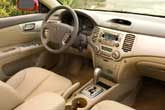
Comfort
Comfort Kia might wish to consider redesigning the 2006.5 Optima’s front seats, which are too flaccid to hold a body in place during moderate cornering let alone spirited drives. That’s too bad, given how capable the steering, suspension, brakes, and tires are. Comfort, a critical factor that can make or break any new model, is elusive in the 2006.5 Kia Optima – at least for this writer. The front seats don’t travel back far enough in the track for taller people, and they feel a size too small – narrow, with short cushions. Making matters worse, they offer virtually no bolstering, a shame given the Optima’s capable suspension, steering, braking, and optional 17-inch tires. The car grips well and would be more entertaining and less work to drive if you weren’t fighting the laws of physics to keep your butt planted in the seat. Finally, the driver’s seat height adjusts, but the higher it goes, the flatter the bottom cushion gets, removing what little thigh support there is to begin with. Kia definitely needs to go back to the drawing board with these seats, though it must be noted that a female companion for the drive back to Los Angeles from San Francisco had no complaints about seat comfort. Whether the driver or front passenger, I just couldn’t get comfortable. Bigger seats with better thigh support and more seat track travel are a must-have, in my book. On the plus side, the new Optima’s steering wheel is good to grip, the upper door panels are soft with a gently curved edge, and there’s a telescopic steering wheel. One benefit of choosing the EX Leather Package is that the perforated leather inserts and door panels look much, much nicer than the raggedy cloth in the LX. Additionally, the center console lid in the Optima EX with the Leather Package features smooth stitched cowhide where you rest your arm, but there’s little padding, making it less comfortable than it could be. Rear seat comfort is average for the class. Tall passengers can sit in back without their legs touching the front seatbacks, but the Optima doesn’t offer cross-your-legs comfort unless Shorty is driving. There’s a fold-down armrest in back, good thigh support, and decent foot room. Getting in and out of the rear seat is also pretty easy, which cannot be said for many midsize sedans.
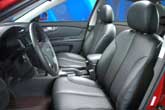
Driving Impressions
Driving Impressions The 2006.5 Kia Optima is a smooth, capable, communicative machine, and our pick is the four-cylinder model. The optional V6 has got to go, standing out as the lame duck, mechanically. Gordon Dickie is a suspension tuning guru that Kia stole from Mazda several years ago. He’s also the man charged with cultivating the fun-to-drive feel that Kia wants every one of its vehicles to possess. Dickie refused to sign off on this 2006.5 Kia Optima redesign until he had the underpinnings set up to his liking, but the delay in getting to market was worthwhile. He benchmarks BMW for ride and handling, and this is clear from the moment you twist the Optima’s key, select a gear, and set off down the road. The 2006.5 Kia Optima is a smooth, capable, communicative machine. The optional 17-inch tires grip well, but the Optima does push wide in turns, and the rubber isn’t shy about announcing its limitations. The suspension soaks up road anomalies like a good European sports sedan, swallowing bumps, dips, and potholes with equal aplomb. The driver always knows what’s happening at the road surface tactilely and aurally, but the communication is rarely intrusive. The Optima’s brake pedal feels terrific underfoot, letting the driver dial in just-right amounts of pressure to the pads, and the steering is responsive with perfect assist levels. When you look at the spec chart and see that the Optima’s weight distribution ranges from 60.6/39.4 front/rear in the four-cylinder manual to 62.1/37.9 front/rear in the V6, its handling is even more surprising. The car just doesn’t feel nose heavy, ever. This predisposition to utter driving competence makes the Optima’s V6 powertrain that much more disappointing. It’s geared to feel strong off the line, but it runs out of steam quickly and the five-speed automatic refuses to offer snappy shifts, gliding between gears instead. Manual shifting helps little, since there’s no point in revving the engine, but at least Kia’s Sportmatic setup requires a tap down for a downshift and a tap up for an upshift – none of BMW’s and Mazda’s F1-for-the-masses nonsense for this manually interactive automatic. Kia might be positioning the new Optima as a sporty four-cylinder value proposition, but this V6 has got to go. It’s adequate at best, and stands out as the lame duck mechanically. Our pick is the four-cylinder model. With the automatic, it’s geared for good response off the line, and accelerates with verve. The engine is refined, and the automatic seems to work better with this engine. Sportmatic is also more worthwhile, as the four doesn’t mind revving. Getting a four-cylinder with a stick and the 17-inch wheels would make for a fun, affordable sedan, but Kia doesn’t offer that combination. Those interested in a softer ride and a quieter interior should check out the standard 16-inch wheels and tires, which deliver on both counts but not at the expense of the Optima’s capable handling characteristics and road feel. There are many reasons to consider purchasing the Optima EX, but one of the best is for its standard Infinity stereo. This audio system rocks with 360 watts of power, nine speakers, and eight-channel amplification capable of 45 watts each. It sounds crisp, clean, clear, and delivers resonant bass. But what’s up with the cassette deck? Is this 1996 instead of 2006? Plus, this car needs an iPod jack, which is rapidly becoming a deal-maker or -breaker with young customers. On twisty roads, the 2006.5 Kia Optima shows promise as an entertaining family sedan – it just needs better seats and a more powerful V6 engine. In the city, the 2006.5 Kia Optima soaks up potholes and broken pavement, proves easy to park, and offered enough verve from its four-cylinder engine to tackle the hilly streets of San Francisco. As a long distance road tripper, the 2006.5 Kia Optima needs work. The front seats don’t leave occupants refreshed, there’s wind noise at speeds above 70 mph, and while the Optima was quiet on the grooved and sectioned concrete of L.A’s network of freeways, traveling the various surfaces of Interstate 5 through California’s central valley showed that the cabin is hushed only on the smoothest blacktop. Plus, we didn’t get near the fuel economy the EPA says we should have on this trip.

FAQs
FAQs Contrary to popular belief, the 2006.5 Kia Optima is not a restyled Hyundai Sonata. It’s based on a smaller, separate platform – which explains why the Sonata’s 3.3-liter V6 doesn’t fit in the new Optima. Why offer a V6 engine in the 2006.5 Kia Optima if it makes just 24 more horsepower and 19 more lb.-ft. of torque than the four-cylinder model? Kia is focusing on the four-cylinder models, and plans to stock dealerships in an 80/20 blend of fours and V6s. Ian Beavis, Kia’s VP of marketing, says that with fuel prices going the way they are and renewed customer interest in fuel economy, this is the right strategy. Yet, noted Kia’s COO Len Hunt, some customers want a V6 engine no matter what. He says that by offering the old Optima’s improved 2.7-liter V6 as an option, the new Optima provides a good value equation for a V6-powered sedan. When we asked Alex Fedorak, Kia’s director of public relations, why the new Optima didn’t get the powerful new 3.3-liter V6 engine that parent company Hyundai supplies in the Sonata midsize sedan, he explained that contrary to popular belief, the Sonata and the new Optima are on separate platforms, so the corporate 3.3-liter V6 wasn’t a part of the plan. How different from the Hyundai Sonata is the new 2006.5 Kia Optima? Looking at the specifications, the Optima is a smaller car than the Sonata. Its wheelbase and overall length are shorter, its track and width are narrower, and its trunk is smaller. The Optima weighs more than 100 pounds less, and offers less headroom, shoulder room, and hip room. Plus, the Kia is down more than 15 cubic feet in overall interior passenger space compared to the Hyundai. However, the Optima is taller than the Sonata, and offers more front leg room for the front passenger while matching the Hyundai in terms of driver leg room. If the 2006.5 Kia Optima is smaller than the Hyundai Sonata, and the V6 version is substantially less powerful, and they offer the same excellent warranty protection, why should I choose the Kia? First, the Kia Optima is more pleasing to drive than the Hyundai Sonata, even if the Sonata V6 spanks the Optima V6’s butt in a straight line. The Optima’s suspension, steering, and brakes are near perfection, and since the four-cylinder engines are virtually identical, the Optima’s lower curb weight translates into sprightly performance. Plus, only the Optima pairs a five-speed automatic with the four-cylinder engine; the Sonata has a four-speed unit. Second, the Kia Optima is less expensive than the Hyundai Sonata, though once you add the ABS and stability control systems that come standard on the Hyundai but are optional on the Kia, that value equation suffers erosion, making the remaining price differential easier to swallow for the Hyundai’s larger interior and bigger trunk. Third, the Kia Optima EX is equipped with a stunningly good Infinity sound system. So what’s it gonna be? A powerful V6 and a roomier cabin in the Sonata, or nimble handling, great music, and a lower price with the Optima?
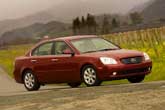
Specifications
Specifications The 2006.5 Kia Optima’s closest competitors include the Chevrolet Malibu, Chrysler Sebring, Dodge Stratus, Ford Fusion, Honda Accord, Hyundai Sonata, Mazda 6, Mitsubishi Galant, Mercury Milan, Nissan Altima, Pontiac G6, Suzuki Verona, Toyota Camry, and Volkswagen Jetta. Test Vehicles: 2006.5 Kia Optima LX V6; 2006.5 Kia Optima EX Price of Test Vehicles: $21,345 (LX V6 – includes $600 destination fee); $22,695 (EX Leather Package – includes $600 destination fee) Engine Size and Type: 2.4-liter inline four-cylinder; 2.7-liter V6 Engine Horsepower: 161 at 5,800 rpm (4-cyl.); 185 at 6,000 rpm (V6) Engine Torque: 163 lb.-ft. at 4,250 rpm (4-cyl.); 182 lb.-ft. at 4,000 rpm (V6) Transmission: Five-speed automatic with manual shift feature Curb weight, lbs.: 3,179 (4-cyl. automatic); 3,287 (V6) EPA Fuel Economy (city/highway): 24/34 mpg (4-cyl. automatic); 22/30 mpg (V6) Observed Fuel Economy: 23.4 mpg Length: 186.4 inches Width: 71.1 inches Wheelbase: 107.1 inches Height: 58.3 inches Leg room (front/rear): 43.7/37.8 inches Head room (front/rear): 39.8/38.0 inches Max. Seating Capacity: Five Max. Cargo Volume: 14.8 cu.-ft. Competitors: Chevrolet Malibu, Chrysler Sebring, Dodge Stratus, Ford Fusion, Honda Accord, Hyundai Sonata, Mazda 6, Mitsubishi Galant, Mercury Milan, Nissan Altima, Pontiac G6, Suzuki Verona, Toyota Camry, Volkswagen Jetta
Photos courtesy of Kia Motors, photographed by Greg Jarem
